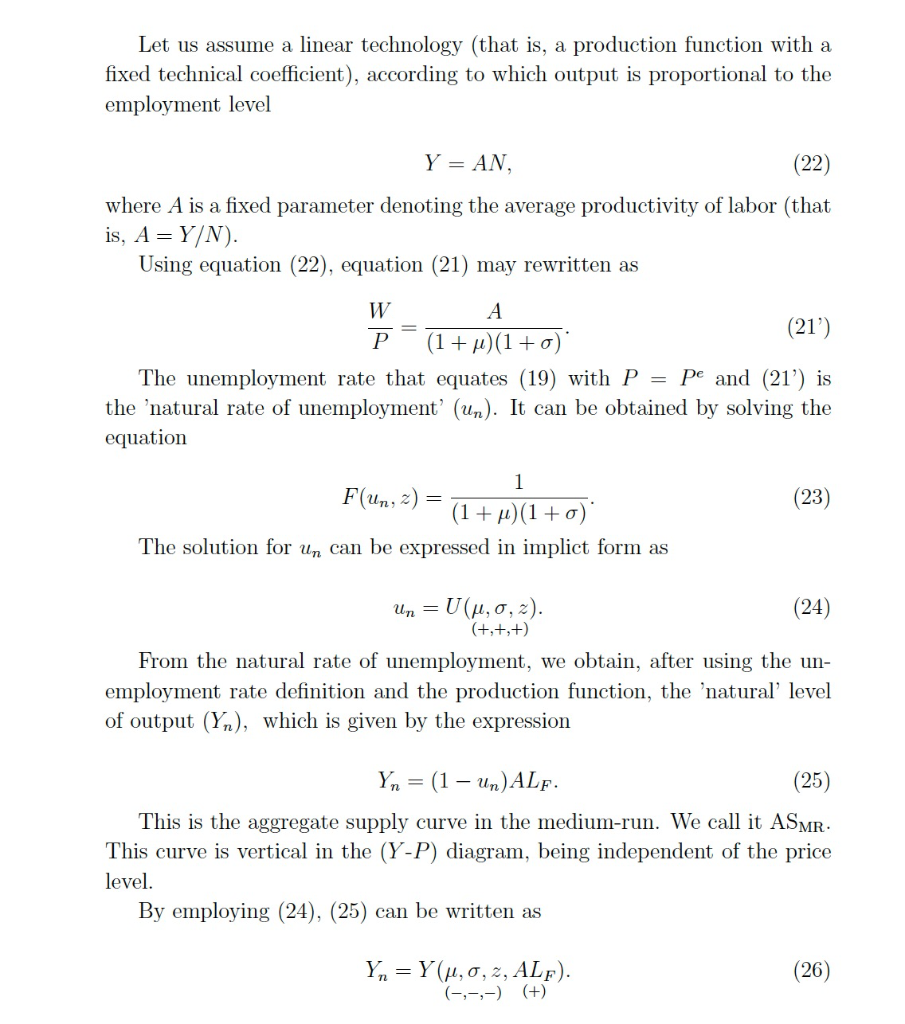Answered step by step
Verified Expert Solution
Question
1 Approved Answer
Please explain to me how the lecturer went from 21 to 23. Please provide a step by step explanation for the rewriting of the equation.


Please explain to me how the lecturer went from 21 to 23. Please provide a step by step explanation for the rewriting of the equation.
3 Medium-run: The AD-AS model Analyze the closed economy of Section 2 in the medium-run, when the ag- gregate price level is fully flexible and P = Pe. 3.1 Labor market equilibrium: The WE-PE model and the AS curve Consider a labor market with price setters (firms) and wage setters (unions and/or firms). There are two type of imperfections: one regarding the prod- uct market and one the labor market. The labor market equilibrium can be described by using the wage-setting equation (WE) and the price-setting equation (PE). The wage-setting is described by the relationship W = Pe AF(u , z), (- (19) ). where W is the nominal wage, Pe is the expected price level, A the average labor productivity, F(:, .) the implicit function of the expected real wage in productivity terms, u the unemployment rate, z an exogenous variable, cap- turing either the tightness of the labor market or the role of unemployment subsidies on the wage determination. The unemployment rate is defined as (20) (LF - N) u= LF where LF is the labor force and N the employment level. As in the medium-run expectations are realized, P = Pe in (19). Firms fix prices by setting a mark-up (p) on labor costs per unit of output. The price setting equation (PE) is WN P = (1+)[(1+0), where o is the payroll tax rate. (21) Let us assume a linear technology (that is, a production function with a fixed technical coefficient), according to which output is proportional to the employment level Y = AN, (22) where A is a fixed parameter denoting the average productivity of labor (that is, A = Y/N). Using equation (22), equation (21) may rewritten as W A P (1+x)(1+0) (21) The unemployment rate that equates (19) with P = Pe and (21') is the 'natural rate of unemployment' (un). It can be obtained by solving the equation = (23) 1 F(Un, 2) (1+x)(1+0) The solution for Un can be expressed in implict form as Un = U(u, 0, ). (24) (+,+,+) From the natural rate of unemployment, we obtain, after using the un- employment rate definition and the production function, the 'natural level of output (Yn), which is given by the expression Yn = (1 Un)ALF. (25) This is the aggregate supply curve in the medium-run. We call it ASMR. This curve is vertical in the (Y-P) diagram, being independent of the price level. By employing (24), (25) can be written as Yn = Y(u,0, Z, ALF). (-;-;-) (+) (26)Step by Step Solution
There are 3 Steps involved in it
Step: 1

Get Instant Access to Expert-Tailored Solutions
See step-by-step solutions with expert insights and AI powered tools for academic success
Step: 2

Step: 3

Ace Your Homework with AI
Get the answers you need in no time with our AI-driven, step-by-step assistance
Get Started


